MyPortugalHoliday.com
The best independent guide to Central Portugal
MyPortugalHoliday.com
The best independent guide to Central Portugal
Evora sights and activities: things to see and do in 2025
Évora lies at the heart of the Alentejo region and is a fascinating city, boasting a rich history, unique sights and an authentic Portuguese atmosphere.
The city has a delightful historic centre that has barely been altered since the 15th century, when it was a favourite with the Portuguese nobility and served as an influential religious centre.
Within the city you will discover many impressive sights, including a Gothic cathedral, a beautifully preserved Roman temple, one of Portugal's oldest universities and a macabre bone chapel. Between these attractions lies a warren of cobbled streets filled with traditional houses, bustling cafés and tempting restaurants.
Évora makes a wonderful tourist destination, popular as a day trip from Lisbon or as part of a tour of central Portugal. This guide details the best sights of Évora, helping you make the most of your visit to this historic city.
Related articles: Introduction to Evora
The top 10 sights in Evora
There are many fascinating sights in Évora, and the top 10 essential attractions are:
1) Roman Temple - beautifully preserved ancient temple with elegant granite columns
2) Sé Cathedral - imposing Gothic cathedral with stunning rooftop views
3) Capela dos Ossos (Chapel of Bones) - macabre chapel lined with 5,000 skeletons
4) University of Évora - Portugal's second oldest university with historic courtyards
5) Praça do Giraldo - bustling main square and heart of the city
6) Almendres Cromlech (neolithic stones) - 6,000-year-old stone circle outside the city
7) Aqueduct de Prata - impressive 16th-century aqueduct with towering stone arches
8) São Francisco church - historic Franciscan church housing the bone chapel
9) Jardim Público de Évora - peaceful public gardens with palace ruins
10) Évora Museum - local history museum with archaeological treasures
The map below shows the location of the main sights of Evora (Note: Zoom out to see all of the points)
Key 1) Roman Temple 2) Sé Cathedral 3) Capela dos Ossos (Chapel of Bones) 4) University of Évora 5) Praça do Giraldo 6) Almendres Cromlech (neolithic stones) 7) Aqueduct de Prata 8) São Francisco church 9) Jardim Público de Évora 10) Évora Museum 11) Rua Cinco de Outubro 12) Igreja da Graça 13) Igreja de São João Evangelista 14) Palácio de Dom Manuel I 15) Fonte das Portas de Moura 16) Igreja do Salvador do Mundo 17) Arco Romano de Dona Isabel
The Roman Temple of Evora (Templo Romano de Évora)
Standing at the highest point of Evora is a beautifully-preserved Roman temple dedicated to Emperor Augustus and the cult following that existed during his rule.
The temple is remarkably well-preserved, with 14 of its 18 original, elegant granite Corinthian columns standing on the 3-metre-high podium, each decorated with delicate marble carvings.
The Templo Romano managed to survive much of Evora's turbulent history, as it was incorporated into the Castle of Évora during the Middle Ages and later used as a slaughterhouse.
The temple is free to view and stands on the edge of the pretty Jardim Diana garden.
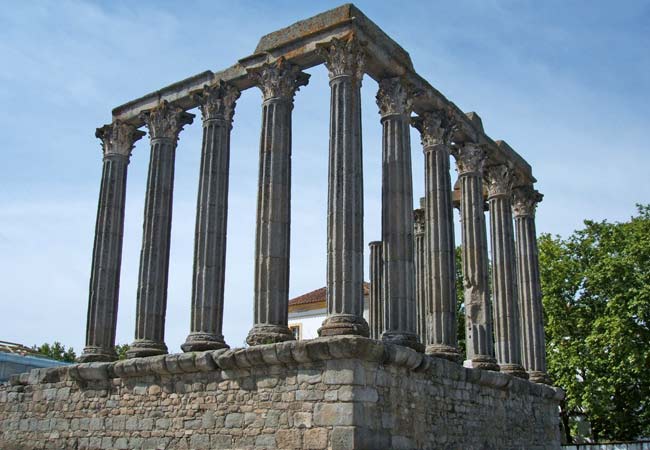
There were 18 Corinthian columns when the temple was constructed, with 14 still standing today
Have you considered an organised tour to Évora?
An organised tour is a fantastic way to discover Évora, particularly if you are staying in Lisbon. The quality of tours in Portugal is very high, with knowledgeable and enthusiastic guides who design tours for modern tourists. A tour combines many attractions into a single day and avoids the hassle of public transportation.
We have worked with GetYourGuide over the past six years, and some of their best excursions to Évora departing from Lisbon include:
The Praça do Giraldo plaza
The Praça do Giraldo is the bustling heart of Evora, with the eight main streets of the city leading out from the plaza.
The plaza retains much of its medieval character, where it played host to daily markets and monthly bullfights, as well as being the source of the city's water via the Fonte da Praça fountain.
The Praça do Giraldo conceals a dark history, as it was the site of the 16th-century inquisitions, where courts would convict heretics who would be burnt on great pyres set up in the plaza.
Today the Praça do Giraldo is the lively centre of Évora, filled with open-air cafés, restaurants and a constant stream of shoppers. Standing on the northern side of the plaza is the impressive Igreja de Santo Antão church and the 17th-century Fonte da Praça.
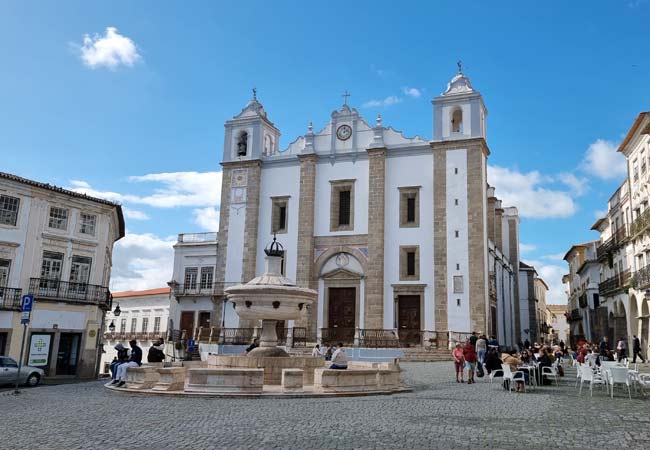
The Igreja de Santo Antão and Fonte da Praça
The Capela dos Ossos (Chapel of Bones)
The creepy Capela dos Ossos (Chapel of Bones) is the most popular tourist attraction of Evora.
This small chapel, which was originally attached to a Franciscan monastery, is lined with the bones of 5,000 skeletons that were exhumed from the five graveyards of Evora during the 16th century.
The majority of the bones are respectfully stacked in recesses in the walls, but they are also used to decorate the chapel. The vaulted arches are lined with skulls, femur bones cover the central pillars, and disturbing motifs are created from an assortment of bones. Adding to the ghoulish atmosphere, the vaulted ceiling is painted with death-focused frescoes and two mummified bodies that were exhumed are placed on prominent display.
To counter all of the death, a delightful collection of nativity scenes is exhibited in the room above the chapel.
The entrance fee is €6, and due to the chapel's popularity it is best to visit early in the day.
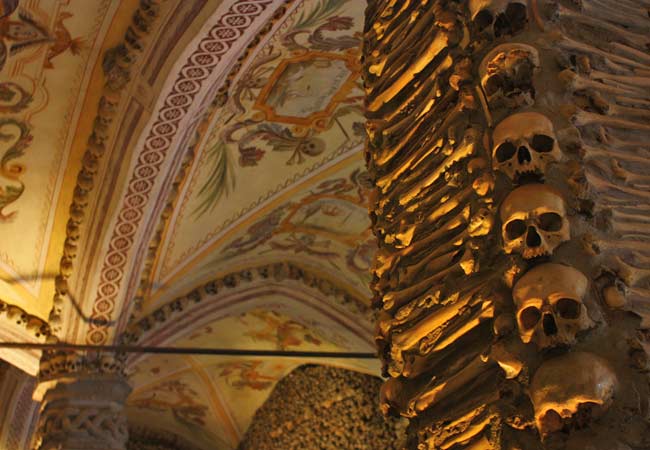
Countless skulls stare down from the walls of the Capela dos Ossos
Aqueduto da Água de Prata (Évora Aqueduct)
Aqueduto da Água de Prata is one of the most impressive construction projects of the 16th century, and provided a constant supply of water to the city.
The network of channels and aqueducts connects Evora to a year-round spring of water in the village of Graça do Divor, 18km to the northwest. For the majority of the route, the water flows through submerged tunnels. However, from the Convento de São Bento de Cástris, the water is carried via a series of massive stone aqueducts.
These arches rise to 30m high outside of the city walls, while inside the city, houses have been built beneath these grand stone arches. The water system continued through the city to the Praça do Giraldo, where the water originally flowed out of the Fonte da Praça fountain.
The aqueduct lies to the north of the city and is best seen along the Rua do Cano and where it crosses the IP2 road.
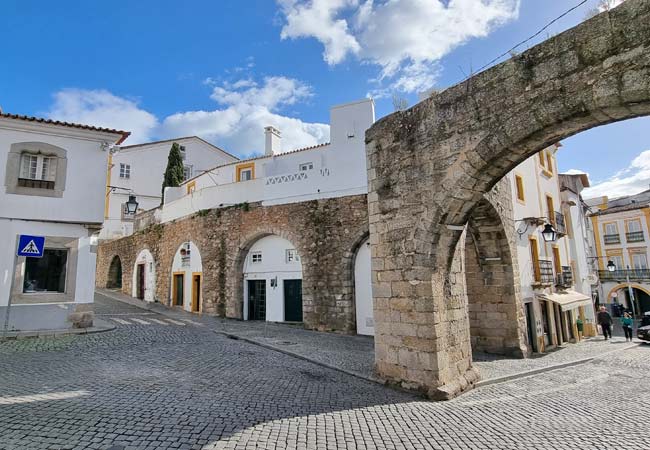
The arches start relatively small along the Rua do Cano
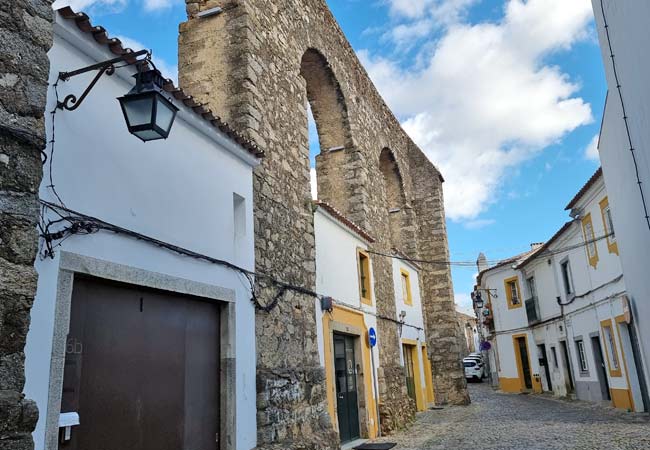
But soon, they tower above the houses and street
The Almendres Cromlech
The Almendres Cromlech are some of the most important Neolithic structures found in Western Europe. This massive formation of over 100 standing stones precisely measured and tracked the celestial movements of the planets and stars.
The site is over 6,000 years old but was in constant use for many centuries, with multiple additions to the elliptical stone circles.
The stones were not just simply placed in a formal arrangement; many of the stones are decorated with patterns and engravings, with meanings unknown.
The Almendres Cromlech lie 19km to the west of Evora (GPS: 38.559, -8.061) and is a wonderful sight to visit if you have a car.
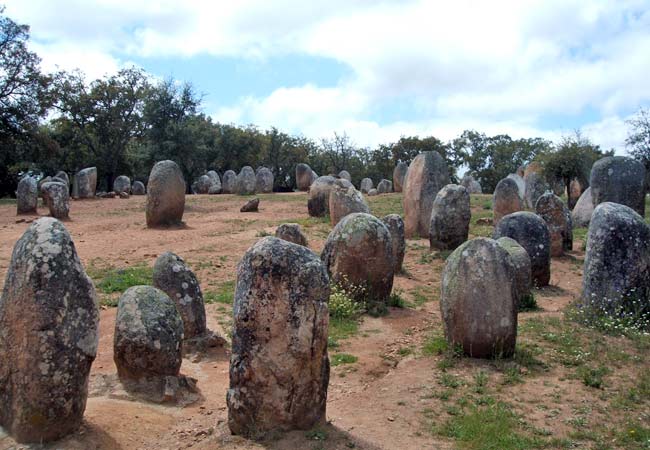
The Almendres Cromlech are a good day trip from Evora
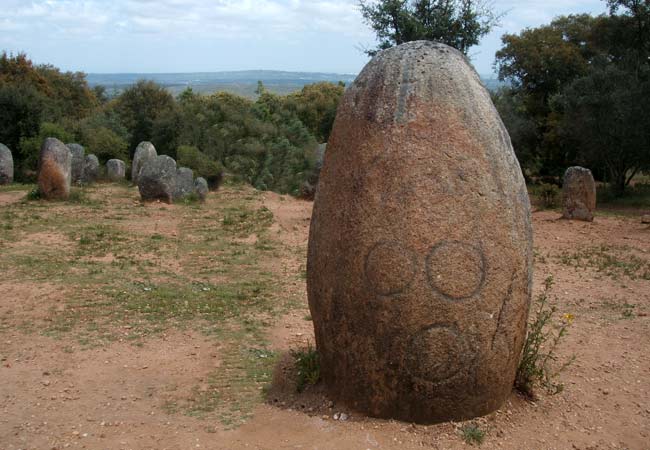
Sé Catedral de Évora
The Se Cathedral is the imposing cathedral at the heart of Evora, which is one of the finest examples of the transition from Romanesque to Gothic architecture in Portugal (many of this era's grand buildings were destroyed by the 1755 earthquake).
Inside the sombre, granite stone cathedral are gilded altars and an impressive high altar, but for most tourists the exterior areas are more interesting. This includes the roofs of both the cathedral and cloister complex , which provide wonderful views over Evora.
Notable features of the cathedral include the mismatched towers (one ends in a conical spire and the other is a tiled bell tower) and the Gothic stone carvings of the apostles flanking the entrance.
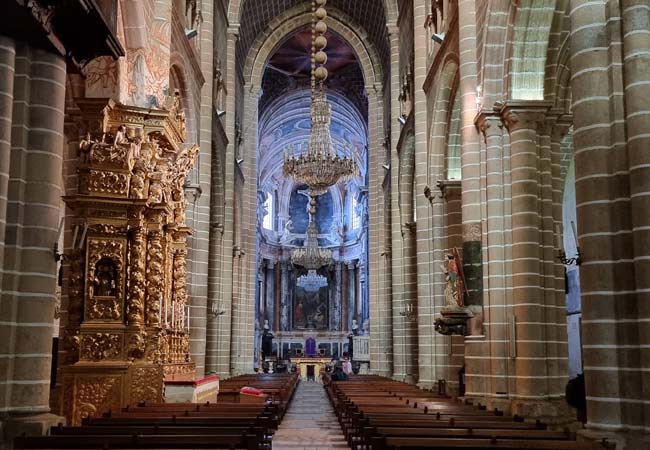
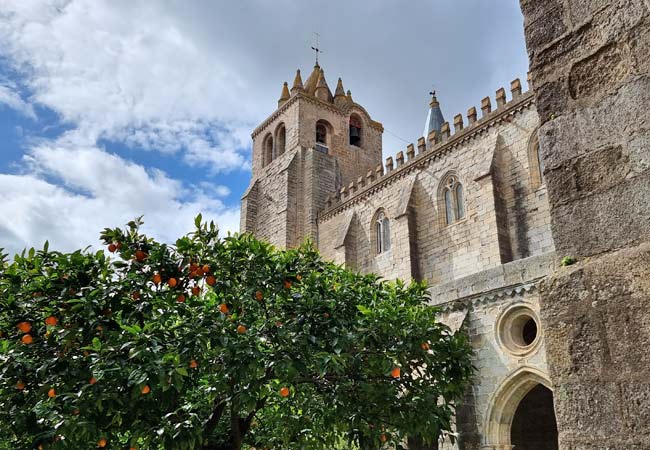
The cloister of the Cathedral
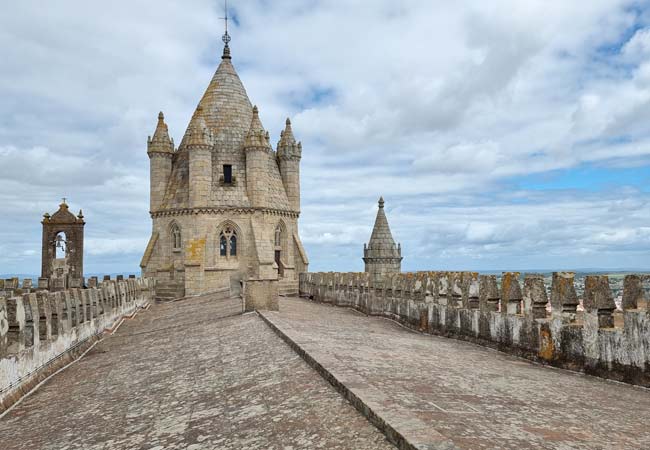
There is a magnificent view from the top of the roof of the cathedral
Cork and the Rua Cinco de Outubro
One of the main exports of the Alentejo region is cork, and there is no better place to see the varied uses (and gifts!) than along the Rua Cinco de Outubro.
This very pretty street leads from the Praça do Giraldo up to the cathedral and is lined with numerous craft and artisan gift shops. Within the shops, you can find cork that has been created into bags, shoes, ornaments and even clothes.
At the top of the street is the Rota dos Vinhos do Alentejo, which offers wine tasting of the Alentejo region's wines. Another highlight is the Páteo restaurant which, along with its delicious food, allows you to see what the courtyard of a traditional house looks like.
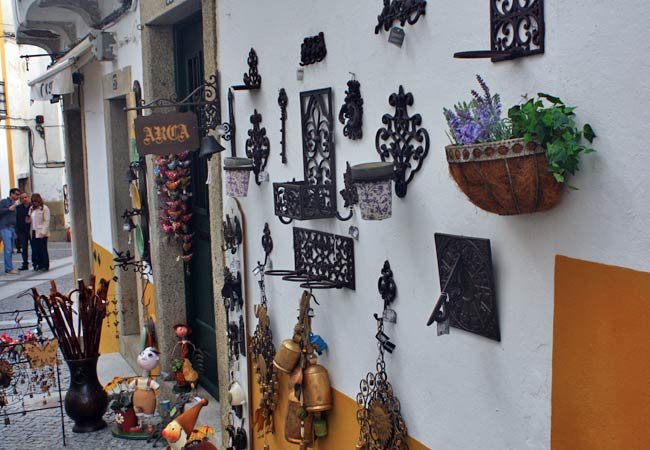
The Igreja da Graça
The Igreja da Graça is a beautiful example of Renaissance architecture and is notable for its four Atlas-style figures that represent the four corners of the Earth - and the implied power of King João III.
The inside of the church is very bare, having been abandoned after the abolition of religious orders in 1834, with its religious art and altars transferred to the Igreja de São Francisco.
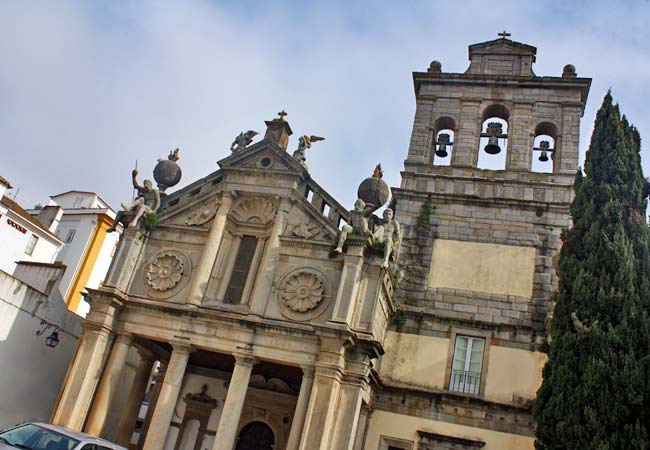
Muralhas de Évora - City walls
Encircling the historic centre of Evora are the medieval walls, which were constructed during the 15th century under the order of King Afonso IV. These are known as the ‘new walls’ and are some of the best-preserved walls in Portugal, being fully intact and extending for 9km.
There is a very scenic pathway on the outside of the walls, offering a pleasant route for an evening stroll if you have longer in the city.
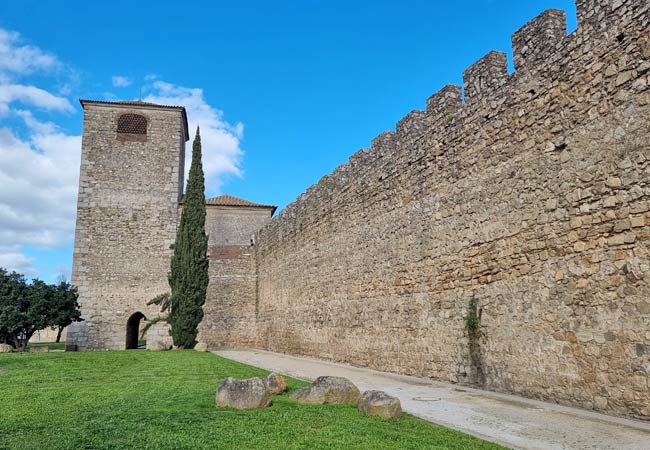
The gardens and pathway around the outside of the city walls
The Roman walls - Cerca Romana
The Cerca Romana walls protected the original Roman settlement at the top of the hill and were later strengthened by the Moors. Sections of these inner walls, along with the towers, are dotted around the historic centre.
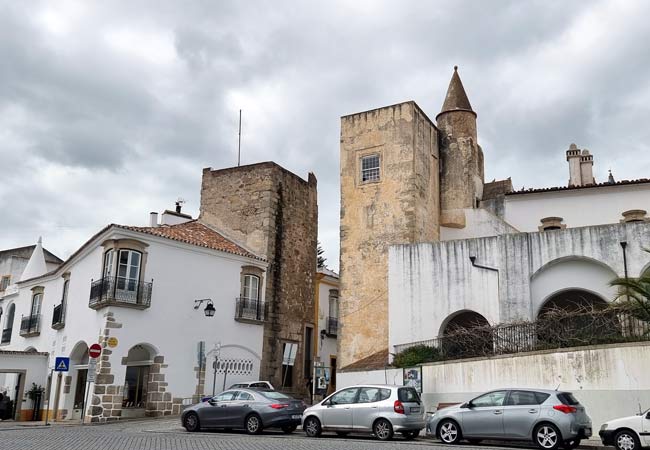
Two Moorish towers of the Portas de Moura gateway
The Universidade de Évora
The University of Evora is the second oldest in Portugal, being established in 1559, and was controlled by the influential Jesuits. It was forced to close in 1779 after a power struggle between the Portuguese nobility and the Jesuits, which led to the expulsion of the Jesuits from Portugal. The university was only re-established in 1971.
The university is centred around the delightful Colégio do Espírito Santo, which was originally the monastery for the Espírito Santo church. Inside the university building, the historic teaching rooms are lined with azulejos tile paintings.
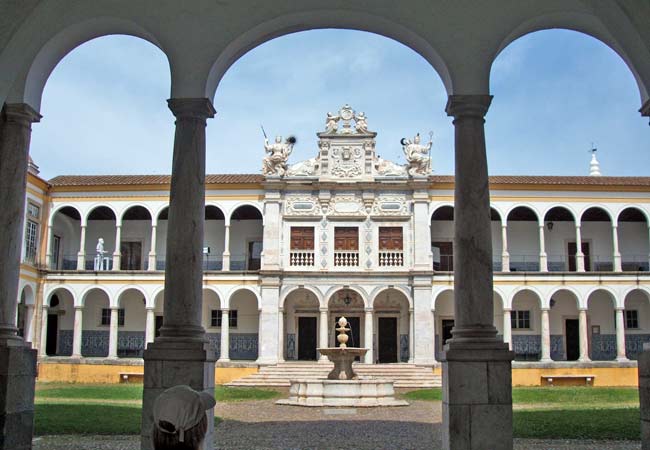
The courtyard of the Colégio do Espírito Santo, which was originally a monastery complex
Igreja de São João Evangelista
The Igreja de São João Evangelista is famed for having some of Portugal's finest azulejos tile paintings, which depict scenes of the Patriarch of Venice and were painted in 1711.
The church was originally constructed as the private pantheon of the Cadaval family, who owned the attached Cadaval Palace.
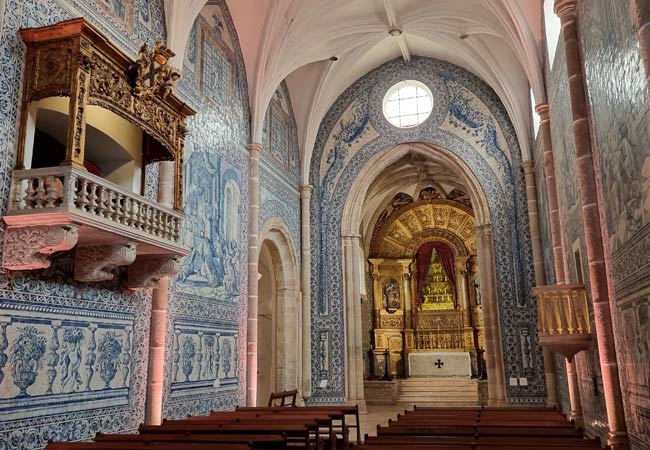
The beautiful, tiled interior of the church
Palácio de Dom Manuel I and the Jardim Público
The Palácio Manuel was the magnificent royal palace during the Portuguese Renaissance of the 15th and 16th centuries. It was here that King Manuel I blessed the flags of Vasco da Gama before his voyage to India (1498), and it was also the wedding venue of King Afonso and Isabel in 1490.
The mighty palace once extended to the Igreja de São Francisco, and included the area where the Mercado Municipal stands today. Sadly, all that remains is the Women's Wing, with its late-Gothic design. Much of the site has been transformed into the Jardim Público and is a pretty park.
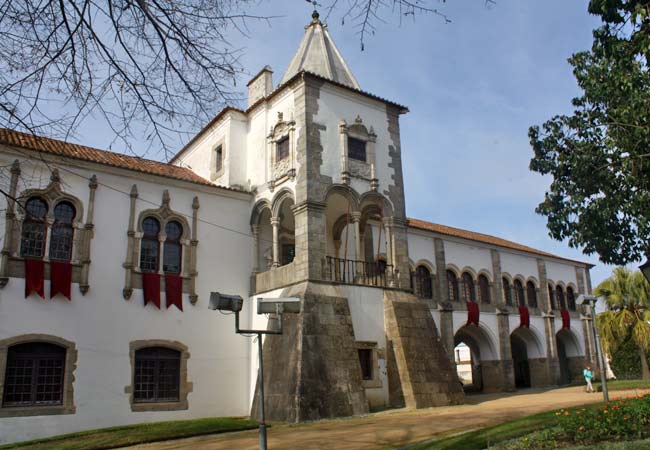
The women’s wing is all that remains of this once grand palace
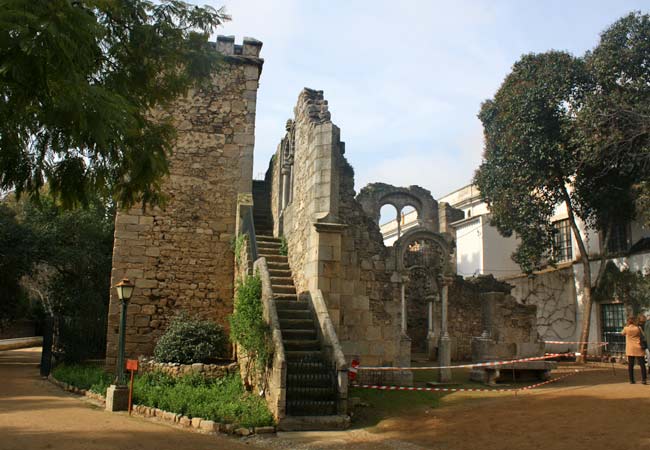
The Ruínas Fingidas (Feigned Ruins) are not from the palace, but were scavenged from around Evora and added to the Jardim Público park as a feature
The Museu de Evora
The Museu de Evora hosts a range of exhibits including archaeological artefacts, paintings and important historical items from Evora. A highlight is the display of 13 panels depicting the life of the Virgin Mary, which originally hung in the cathedral.
The Fonte das Portas de Moura
The Fonte das Portas de Moura was the second set of fountains in Evora where water from the aqueduct flowed out from. The lower tank was used for animals.
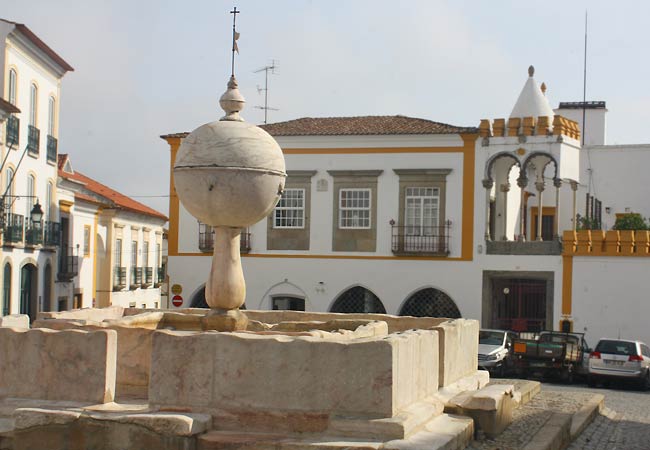
The Igreja do Salvador do Mundo.
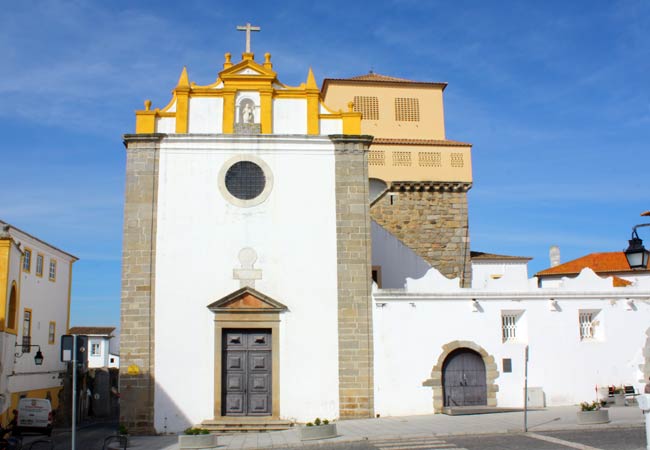
Walking and getting lost in Evora
The main attraction of Evora is the charm of the city itself, and there is no better method to experience the city than by simply getting lost in the old quarter. Evora is a maze of immaculately maintained cobbled streets and traditionally painted houses. Along every street there is a delightful shop, pretty building or small hidden church to enjoy, and these minor sights that are never listed in any guidebooks cannot be discovered without simply wondering around the city.
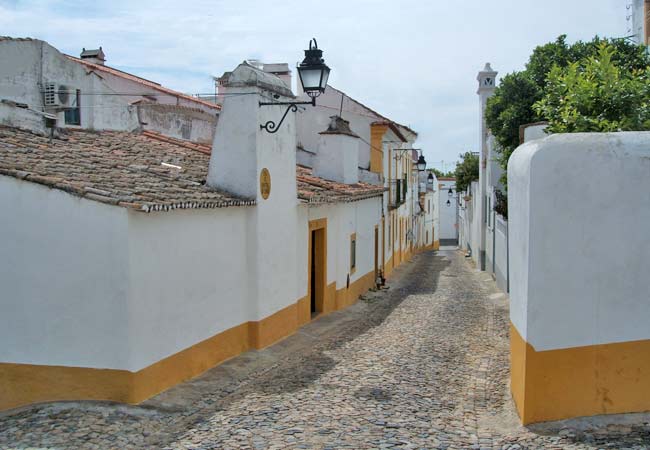
The pretty and traditional streets of Evora


























